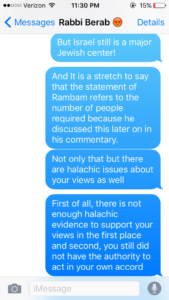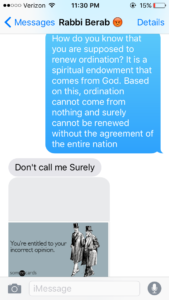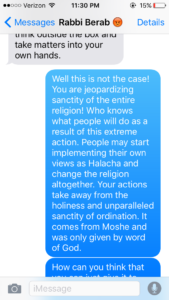Students, draw from talmudic, rabbinic literature and historical sources, to create a dialogue between two 16th century rabbinic figures. Their debate touches on the centrality of rabbinic ordination to the Jewish legal system. Is there a possibility of its restoration and what meaningful ramifications can its return have in the modern day world.
Entry Narrative
The goal of the Rabbinic Ordination Renewal Project was to show students that a topic that at first glance seems archaic and theoretical has very real implications throughout history as well as in the religious, political and eschatological landscape of the modern day State of Israel.
As a teacher of Talmud, one of the most frequent questions I find myself confronting is the relevance of the material we study. The issue is more easily addressed when learning tractates or topics that relate to ritual law or prayer. In these cases students often make immediate connections between the rabbinic debates and their own religious practices. However, close to two-thirds of the Talmud deals with laws about agriculture, tort laws, ritual purity and temple sacrifices. This abundance of rabbinic writing often proves more challenging for students to relate to. As a result students often shy way from these areas of study. The halachic topic of ordination, in theory is one such area. According to most scholars Semikha, (rabbinic ordination) has been lost for almost 1500 years. We can no longer biblically ordain rabbis and the question of how it is done seems mainly theoretical. As such, when beginning this topic students will often ask “but what does this have to do with me?”
This is where the historic debate between Jacob Berab and Ibn Habib comes in. When I introduce the students to the major controversy that raged between two rabbinic figures about the restoration of ordination, and they learn that this debate took place one thousand years after the redaction of the Talmud, all of a sudden this topic breathes new life. However, the students shift from passive observers in the debate to active participants when they discover, through their analysis of historical materials and rabbinic sources, that the point of contention that lied at the heart of Berab’s and Ibn Habib’s dispute was later reintroduced in the debates that raged between the followers and detractors of Zionism with formation of the Zionist movement.
This topic becomes an example that Jewish law is a living breathing system with relevance to each generation. This is reinforced when they follow topic of ordination from its biblical source, to the pages of the Talmud where they see the sages’ concern about the loss of ordination, to the 12th century and the deeply passionate insight of Maimonides about ordination’s renewal, to the debate that raged in Safed in the early 16th century, to the early years of the modern state of Israel, and finally to the online news sites of the early 21st century.
Project Outline
1) Students are first exposed to concept of ordination in a classroom discussion of the Talmud Bavli Sanhedrin 13b-14a. In chavruta learning the students prepare Maimonidies Laws of Sanhedrin 4:1-3. While this is part of a broader discussion about the source, nature and scope of the laws of Sanhedrin, students come across the crucial detail that the chain of Rabbinic ordination no longer exists.
2) Students are given a packet of sources for independent work. The sources are a mix of classic and modern rabbinic sources such as Maimonides, and Radbaz as well as historians such as Jacob Katz. There is also a entry from Encyclopedia Judaica that gives a brief synopsis of the ordination controversy that took place in Safed in 1538.
3) In order to encourage critical reading, before the students begin their analysis of the sources, the teacher explains the background and context of each source and their authors. Students are instructed to be mindful of the different goals of the authors and how that might affect their positions.
4) Students are given a series of guiding questions and translations to help them navigate through the sources. They should record their answers to the questions in a short two page essay.
5) Utilizing their findings from the readings students are told to create a back and forth correspondence between R. Jacob Berab and R. Levi Ibn Habib. They are asked to try, in the voices of Berab and Ibn Habib to show the arguments they would use to persuade the other side. They should try to demonstrate why their motives were so meaningful to them. Why did one side feel so strongly that they needed to reinstate Semikha, while, the other group was so vehemently against it? Finally students are urged to remember that since this conflict became very personal and lasted for a few decades so should try and capture that emotion on in the correspondence.
6) Students are encouraged to present the correspondence in any creative medium they choose so long as the format does not compromise the content. [Students have done project ranging from letters, newspaper editorials, facebook posts, SMS conversations, instagram accounts, screenplays, videos, raps and even a illustrated children’s book]
7) On the day the projects are due we have a final class discussion to review our findings. We discuss themes that have been covered such as personal ambition, passive and active messianism, the role of innovation in Jewish law etc… Students also look at the story of Y.L. Maimon who attempted to restart ordination in the 1950’s and asked to justify and oppose his initiative based on the material they have learned.
8) Finally, students are presented with the basic arguments of religious zionists and anti-zionist for reestablishing a modern day state of Israel. Students are asked how the dispute of the pro and anti-zionist can be seen as an extension of the Berab/Ibn Habib dispute. They are asked to consider if their study of Berab and Ibn Habib has allowed them to look at question of human initiative to establish a Jewish State in a new light.
Images
Images from a student’s SMS conversation:




Cover Page for a student’s “boxing match” project
http://tinyimg.io/i/kO0Lpze.jpg
Entrant Bio(s)
Rabbi David Goldfischer is Assistant Principal and a Talmud teacher at the The Frisch School. In that capacity David coordinates Frisch’s advisory program which ensures that every student has a weekly meeting with a faculty member whose focus is to look after the student’s wellbeing and advocate for his/her needs. Having previously served as the Director of Student Activities and Senior Grade Dean at Frisch, David also oversees all educational programming that takes place during the course of the school year. A graduate of Frisch, David continued his studies for two years in Israel at Yeshivat Har Etzion. He then received his B.A. in English Literature while simultaneously earning Semikha from Yeshiva University. He is currently finishing an M.A. in Modern Jewish History at the Bernard Revel Graduate School of Jewish Studies. Rabbi Goldfischer served as rabbinic intern and then community scholar for four years at Congregation Ahavath Torah, in Englewood, New Jersey. He has also served in Camp Morasha as a member of the education staff for fifteen years. David currently lives in Teaneck, NJ with his wife and five children. In his free time he enjoys learning and seeing comic book movies.

This entry has been tagged with the following terms: